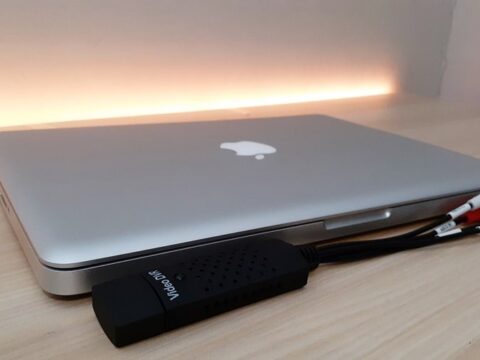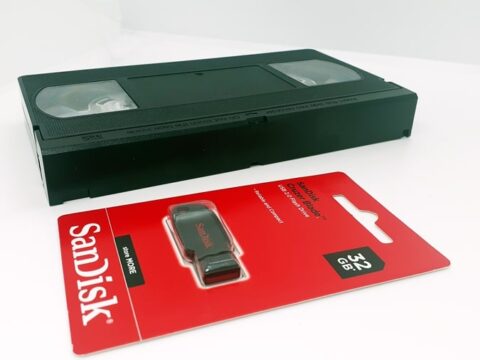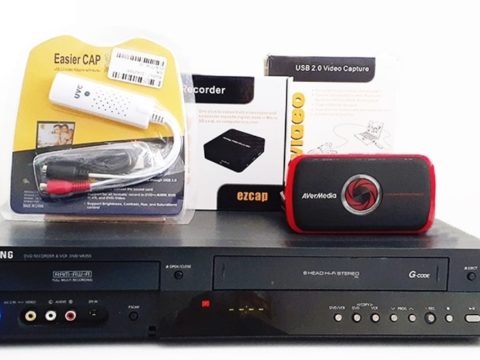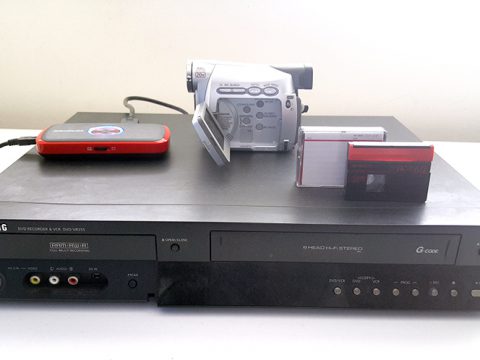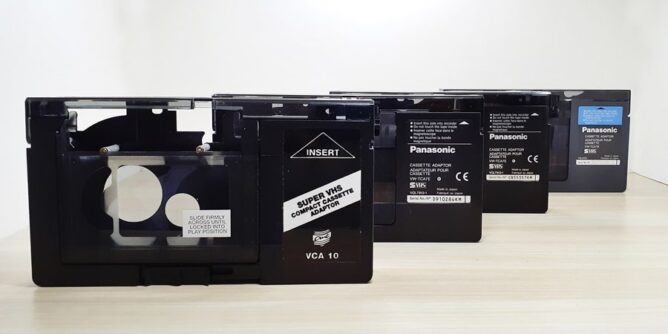
Let’s discuss and answer, what is a VHS C adapter? The amount of times I get asked do you transfer the little cassettes and I have to reply with: which type of little cassette?
Basically, it can get confusing, even though it shouldn’t be.
What I have found, over time when speaking to people about transfers, is that everyone has their own interpretation of a small cassette.
They’re all smaller than a VHS tape therefore they’re all small cassettes.
What is a VHS-C Adapter?
But back to the question: What is a VHS C adapter?

A VHS-C adapter is a device that will allow you to play your VHS-C tapes inside your VCR. Think of it as the bridge between the tape and VCR. By placing the VHS-C tape inside the adapter, this allows it to be the size of a full size VHS tape.
If you don’t have an adapter, you could use the camcorder composite connections to play the VHS-C tape like I explain in this post.

A VHS-C tape format is exactly the same size of a conventional VHS tape.
The main difference being the cassettes will only be in 30 minutes or 45 minutes playback in normal recording.
To give you an idea comparing VHS-C tape alongside a VHS tape, I created a video showing what would happen if you were to combine the tapes.
Some camera brands allowed for recording the tapes into long play, which simply means that you get double the recording time. VCRs that allow for long playback have no issues with these type of recorded tapes.
Difference Between Adapters
There are two types of VHS-C adapters which are: motorized and non motorized. Now while both have advantages over each other, it turns out you have a better chance of finding unicorn blood than trying to get hold of a non motorized VHS-C adapter.
Why that is the case, I’ll never know?
The motorized version can be bought almost anywhere. In fact I’ve seen listings for the non motorized adapter, only to read the details and it clearly states a AA battery is required.
You would think that a device not requiring mechanical pieces would be cheaper to manufacture and sell, but not so.

If we compare the two adapters from a top down view, the non motorized version has a door lid that will spring open when gently pushed to the left.
The motorized version lid will spring open when the latch is slid over to the right.

Along the left hand side another main difference is the battery compartment for the motorized version.
The red lever on the side automatically slides up as the tape is extended into the ready position.

With the door adapter door open, you can see one AA battery is required to make it function. A flat battery is the main reason for any non functioning motorized VHS-C adapters. Something else to remember is to take the battery out if you are not using the adapter.
Batteries leak and end up corroding the metal terminals. One time I opened up one of these adapters that belonged to a customer and it was green inside that little compartment.
Twenty years it had been in there. Looked like Toxic Avenger type crap.
Difference Between Popular Video Cassettes
Some people may ask Why can’t any tape fit into the adapter?
While the answer may seem obvious, I have to remember these types of devices are getting old and probably all look the same to a younger generation.
My generation always say to me I think it takes an adapter, I can’t remember!

So let’s take a quick look at the very basic differences between the popular tapes (for back in the day).
Starting from the left side we have:
MiniDV – The amateur consumer base tape was the smallest of the digital video variants. It would record up to 60 minutes and up to 90 minutes in LP. You can still buy these cameras second hand, but most phones now shoot video at much higher quality than even this digital camera.
Video8 / Hi8 – This format was the competitor for VHS-C brought out in 1985. It’s recording tape length was generally 90 minutes, although you could get 120 minute tapes. It would later be replaced by Hi8 which had a higher resolution, then finally Digital8 which (some models) could playback the original video8 and Hi8 tapes. The last Digital8 camcorder was discontinued in 2009.
VHS-C – The original tape that consumers used for home recordings. Introduced in 1982, this became the popular format due to ease of simply watching through the VCR using the adapter. The tapes would only record for 30 minutes or 60 minutes but could be extended LP mode.

A view of the respective cameras with their tapes.
MiniDV on the left and a Digital8 camera on the right.

Compared to The VHS-C tape, the other two are definitely smaller and thinner. The adapter is strictly made for the VHS-C format.
How To Use VHS-C Adapter
The video below will show what I think of the differences between the cassette adapters.
Personally, my preference is for the manual type of adapters.

For the motorized adapter, simply placing the VHS-C tape into the adapter and closing the lid will start the auto process for stretching the tape.

The non motorized adapter requires a bit of force to extend the tape into its ready position.

What the beginning position looks like on the manual adapter with the top lip up.

After pushing on the lever, the adapter will stretch the tape so that you can place it into a VCR ready to play. At this point the tape can appear loose, so you may need to tighten the white spindle on the bottom clockwise to tighten the tape.
Conclusion
I was very fortunate to get hold of the manual adapter and I thought it would make a good comparison to show people what is/was available online.
For VHS-C tapes, adapters are a necessity if you are going to transfer any old home videos. Especially if you don’t have the camcorder any more. While the motorized versions are easily found, the problem I find is that some break too easily even with mildest drops on counters.
Furthermore, the pricing of the devices seems to fluctuate inconsistently, so finding a bargain can be a pain. That being said, I know if something was to go wrong with any of the adapters I’ll have to buy a new adapter online just like everyone else.

